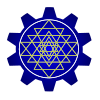If you have done a course in rotational dynamics you would remember the *procedure* involved in solving problems on gyroscopic precession. Don’t remember ? Ok. I’ll give you a refresher.
We use law of gyro-dynamics to solve problems like this – If a vertically upward force is applied to the nose of this propelled-airplane, which direction would it actually move ?

For solving this we were supposed to consider three aspects of rotational motion – the direction of angular momentum of propeller, the direction of external torque and, the direction of precessional torque. (Mind you, all these vector directions are perpendicular to their respective planes ). Ok done. Now raise the right hand, fit these three vectors into your thumb, middle finger and pointer finger. The order to fit in these is… Hey Stop ! there has to be a much simpler and more intuitive way to solve this !
And there is. I had a different way to attack this problem which could solve it almost as fast as I read the question.
The secret is to think in terms of forces involved before plunging into rotational dynamics.
Lets see how.
Figure below shows the forces acting at the center of rotation when the airplane move in a straight line[1]. (When looked from the pilot’s seat )

Let v1 and v2 be the relative velocities of the mutually opposite masses of the propeller. When the center of rotation is stable, v1 = v2. There for the centrifugal forces they exert at centers F1 and F2 are also equal[2]. That is, the centrifugal forces of opposite ends of the propeller mass cancels off each other, exerting no resultant force at the center.
Now think of the force acting vertically upward at the center of rotation (which can be assumed to be at the nose of the airplane). This would cause the center to move upward. Lets see what happens when such a movement is initiated.

The relative velocity of mass at left w.r.t center has now reduced by v0. Also the relative velocity of mass at right has increased by the same magnitude.
Now v2 is clearly greater than v1. Consequently, F2 is greater than F1.
So what happens ? The resultant force moves the nose to the right.
Yes the airplane yaws to the right !
This approach can instantly solve questions on direction of motion of gyroscopes !
[1] – The thrust forward is not considered, for clarity. It doesn’t interfere anyway.
[2] – Its assumed that propeller has uniform mass distribution for points equidistant from the center, which is ideally correct.
Article also available at my previous blog – “http://mindarticulated.wordpress.com/2009/08/01/gyroscopic-precession-the-simple-explanation/”
Kj [/.] Sreekumar programs computers as a hobby and profession. Into programming from his school days, Sree uses Codemarvels to key in facts and fixes he finds interesting while working on different projects. Some of the articles here give away a few shades of his philosophical leanings too.

